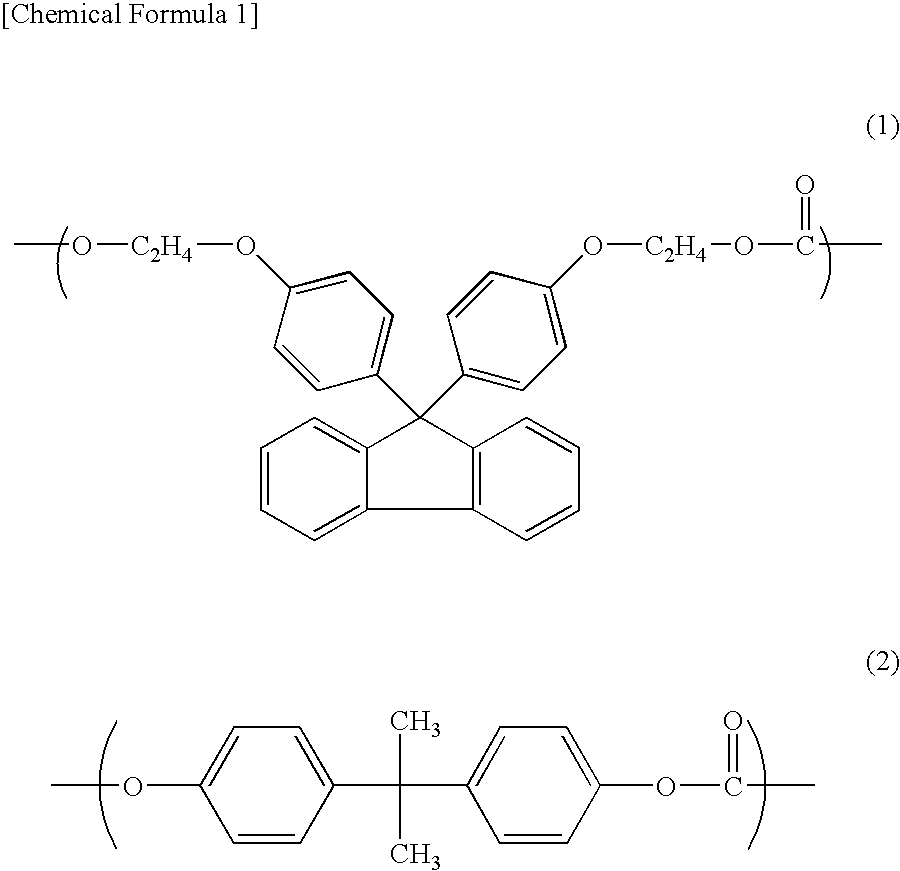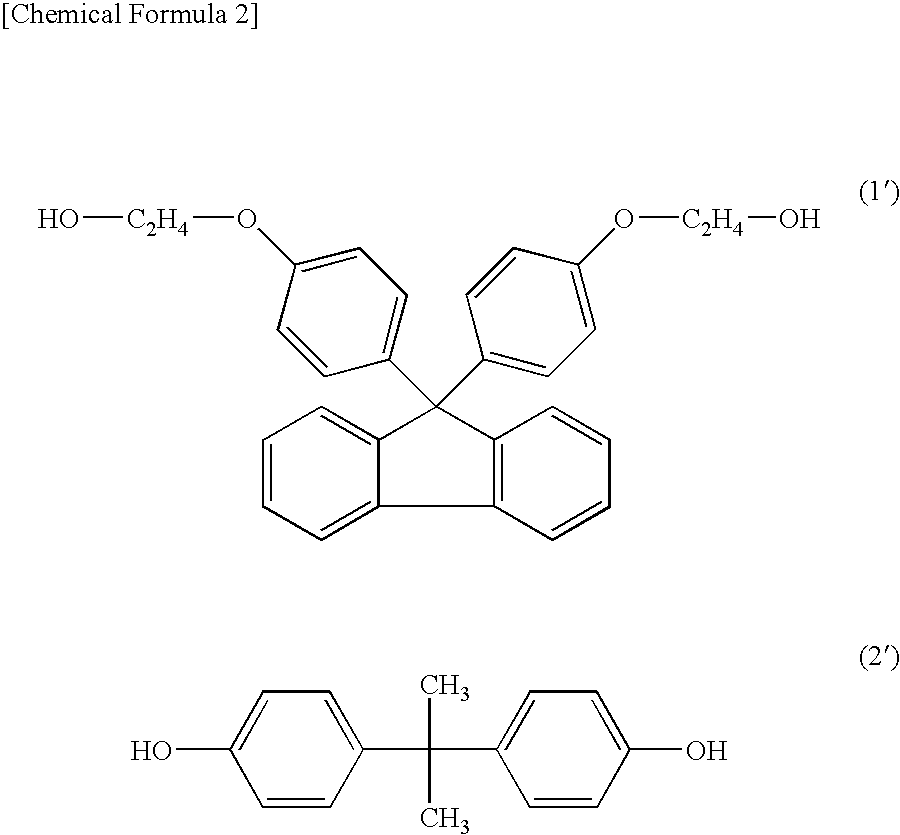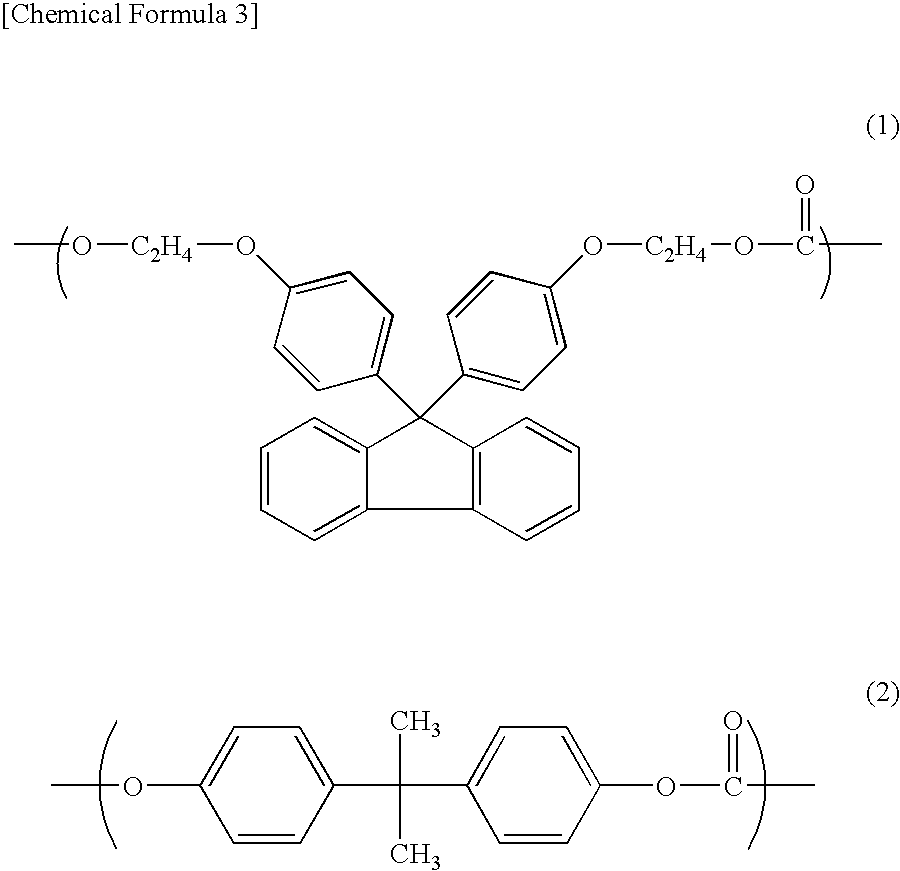Optical Lens
a technology of optical lenses and lenses, applied in the field of optical lenses, can solve the problems of high material cost, poor moldability and low productivity, and high cost, and achieve the effects of reducing the total light transmittance, low birefringence index, and high refractive index
- Summary
- Abstract
- Description
- Claims
- Application Information
AI Technical Summary
Benefits of technology
Problems solved by technology
Method used
Image
Examples
example 1
[0061]22.41 kg (51.11 mol) of 9,9-bis(4-(2-hydroxyethoxy)phenyl)fluorene, 0.1179 kg (0.5162 mol) of bisphenol A, 8.869 kg (52.66 mol) of diphenylcarbonate and 0.02602 g (3.097×10−4 mol) of sodium hydrogen carbonate were charged into a 50-liter reactor equipped with an agitator and a distiller and the temperature was raised up to 215° C. for 1 hour under 760 Torr in a nitrogen atmosphere, and then stirred.
[0062]Then, the degree of reduced pressure was adjusted to 150 Torr in 15 minutes and a transesterification reaction was carried out keeping the conditions of 215° C. and 150 Torr for 20 minutes. Further, the temperature was raised to 240° C. at a rate of 37.5° C. / hr and the reaction system was kept under the conditions of 240° C. and 150 Torr for 10 minutes. Thereafter, the degree of reduced pressure was adjusted to 120 Torr in 10 minutes and the reaction system was kept under the conditions of 240° C. and 120 Torr for 70 minutes. Subsequently, the degree of reduced pressure was ad...
example 2
[0065]15.46 kg (35.26 mol) of 9,9-bis(4-(2-hydroxyethoxy)phenyl)fluorene, 1.203 kg (5.269 mol) of bisphenol A, 8.900 kg (41.55 mol) of diphenylcarbonate and 0.02043 g (2.432×10−4 mol) of sodium hydrogen carbonate were charged into a 50-liter reactor equipped with an agitator and a distiller and the temperature was raised up to 215° C. for 1 hour under 760 Torr in a nitrogen atmosphere, and then stirred.
[0066]Then, the degree of reduced pressure was adjusted to 150 Torr in 15 minutes and a transesterification reaction was carried out keeping the conditions of 215° C. and 150 Torr for 20 minutes. Further, the temperature was raised to 240° C. at a rate of 37.5° C. / hr and the reaction system was kept under the conditions of 240° C. and 150 Torr for 10 minutes. Thereafter, the degree of reduced pressure was adjusted to 120 Torr in 10 minutes and the reaction system was kept under the conditions of 240° C. and 120 Torr for 70 minutes. Subsequently, the degree of reduced pressure was adju...
example 3
[0069]9.167 kg (20.90 mol) of 9,9-bis(4-(2-hydroxyethoxy)phenyl)fluorene, 4.585 kg (20.084 mol) of bisphenol A, 9.000 kg (42.01 mol) of diphenylcarbonate and 0.02066 g (2.459×10−4 mol) of sodium hydrogen carbonate were charged into a 50-liter reactor equipped with an agitator and a distiller and the temperature was raised up to 215° C. for 1 hour under 760 Torr in a nitrogen atmosphere, and then stirred.
[0070]Then, the degree of reduced pressure was adjusted to 150 Torr in 15 minutes and a transesterification reaction was carried out keeping the conditions of 215° C. and 150 Torr for 20 minutes. Further, the temperature was raised to 240° C. at a rate of 37.5° C. / hr and the reaction system was kept under the conditions of 240° C. and 150 Torr for 10 minutes. Thereafter, the degree of reduced pressure was adjusted to 120 Torr in 10 minutes and the reaction system was kept under the conditions of 240° C. and 120 Torr for 70 minutes. Subsequently, the degree of reduced pressure was adj...
PUM
| Property | Measurement | Unit |
|---|---|---|
| mol % | aaaaa | aaaaa |
| mol % | aaaaa | aaaaa |
| mol % | aaaaa | aaaaa |
Abstract
Description
Claims
Application Information
 Login to View More
Login to View More - R&D
- Intellectual Property
- Life Sciences
- Materials
- Tech Scout
- Unparalleled Data Quality
- Higher Quality Content
- 60% Fewer Hallucinations
Browse by: Latest US Patents, China's latest patents, Technical Efficacy Thesaurus, Application Domain, Technology Topic, Popular Technical Reports.
© 2025 PatSnap. All rights reserved.Legal|Privacy policy|Modern Slavery Act Transparency Statement|Sitemap|About US| Contact US: help@patsnap.com



